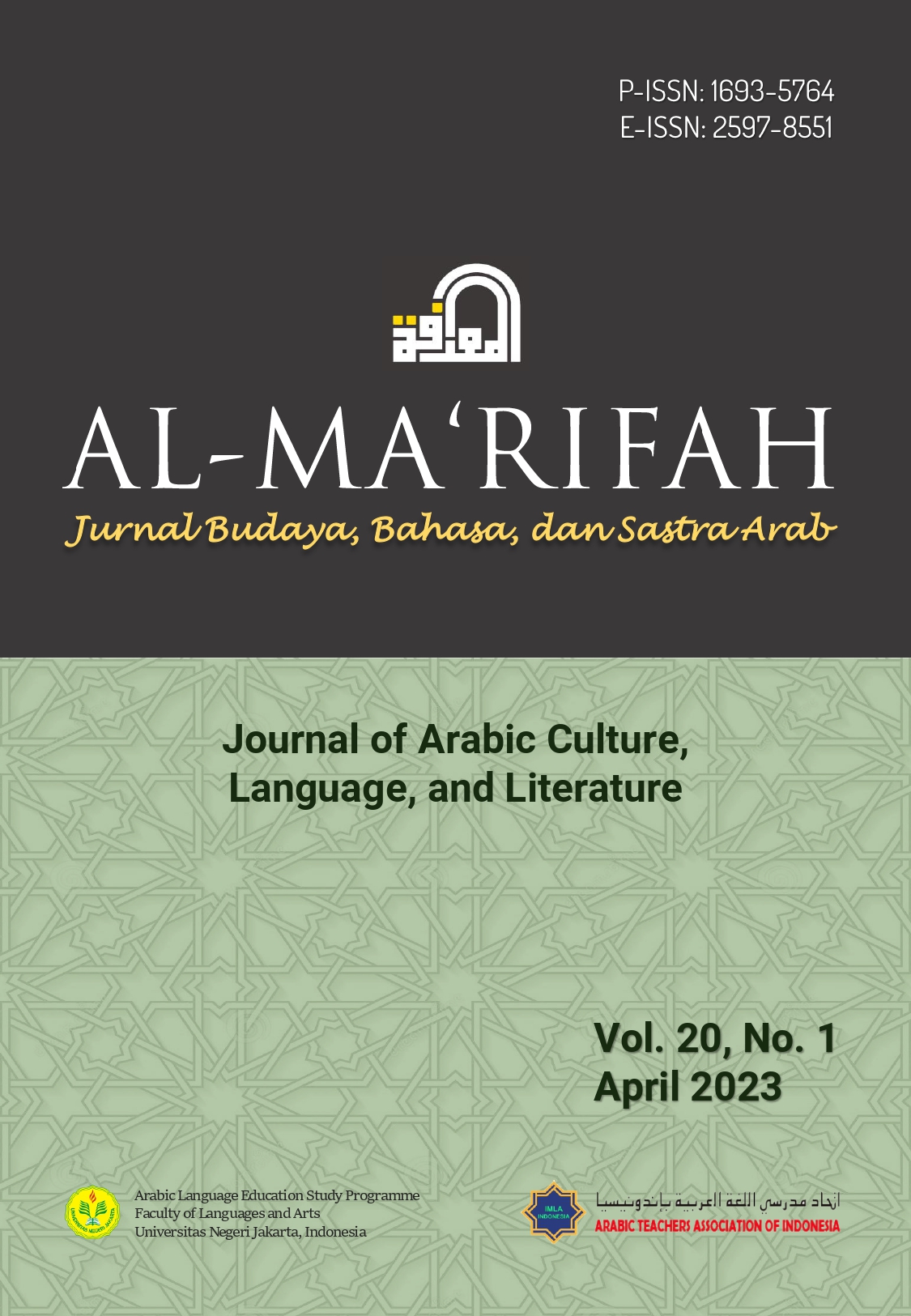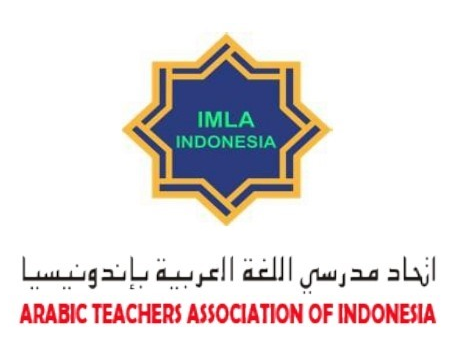Intonation of Interrogative Sentences in Learning Arabic for Mahārat al-Kalām
DOI:
https://doi.org/10.21009/almakrifah.20.01.04Keywords:
Intonation, interrogative sentence, Arabic learning, speaking abilityAbstract
The purpose of this study was to find out the intonation patterns of interrogative sentences for students in class 10 of MAS Al-Hikmah, Soe, Nusa Tenggara Timur, their acceptance by Arabic linguists, and their learning of speaking skills (mahārat al-kalām). This research is a case study that is included in qualitative descriptive research. The data collection technique in this study was to test the intonation of interrogative sentences with the help of the Praat application. The data were analyzed with qualitative descriptive and investigative methods. The results obtained are: first, students of class 10 at MAS Al-Hikmah can apply intonation patterns of Arabic interrogative sentences with varying acceptability values, assisted by teaching aids in the form of articulated sound images and contours. Second, apply the application of interrogative sentence intonation patterns to learning mahārat al-kalām, namely, students and lecturers as parties involved in this learning can apply the principles and fulfill the components of learning Arabic in general.
References
Anh, B. B. H., & Nishimoto, K. (2018). A half-duplex dual-lingual video chat to enhance simultaneous second language speaking skill. In V. L. Uskov, R. J. Howlett, & L. C. Jain (Eds.), Smart Education and e-learning 2017 (pp. 205–214). Cham: Springer International Publishing.
Aziz, M. H., Nawawi, M. S., & Alfan, M. (2020). Pembelajaran mahārat al-kalām pada program kursus bahasa Arab spesial Ramadan di Pesantren Darul Lughah Waddirasatil Islamiyah, Pamekasan, Madura. Al-Ma‘rifah: Jurnal Budaya, Bahasa, dan Sastra Arab, 17(1), 29–40. doi:10.21009/almakrifah.17.01.03
Barona-Oñate, R. V., López-Pérez, S. de los A., López López, J. P., & Mocha-Bonilla, J. A. (2020). Use of e-learning and audio-lingual method for the development of listening comprehension skills. In J. Nummenmaa, F. Pérez-González, B. Domenech-Lega, J. Vaunat, & F. Oscar Fernández-Peña (Eds.), Advances and applications in computer science, electronics and industrial engineering (pp. 83–98). Cham, Switzerland: Springer International Publishing.
Batmang. (2013). Kesalahan fonologis dalam berbicara bahasa Arab pada mahasiswa matrikulasi STAIN Kediri. Al-Izzah: Jurnal Hasil-hasil Penelitian, 8(1), 19–38. Retrieevd from https://ejournal.iainkendari.ac.id/index.php/al-izzah/article/view/85
Bhagath, P., & Das, P. K. (2021). Graph eigenvalue based structural method towards phonetic boundary detection. 2021 IEEE Region 10 Conference (TENCON) (pp. 591–596). Auckland, New Zealand. doi:10.1109/TENCON54134.2021.9707281
Chaer, A. (2014). Linguistik umum. Jakarta: Rineka Cipta.
Daroeni, N., Walfajri, & Khotijah. (2020). Metode pembelajaran keterampilan berbicara bahasa Arab di MAN 1 Metro, Lampung. Al-Ma‘rifah: Jurnal Budaya, Bahasa, Dan Sastra Arab, 17(2), 127–138. doi:10.21009/almakrifah.17.02.03
Dong, J.-W., Liao, Y.-J., Li, X.-D., & Huang, W-b. (2020). The application of big data to improve pronunciation and intonation evaluation in foreign language learning. In J. H. Kim, Z. W. Geem, D. Jung, D. G. Yoo, & A. Yadav (Eds.), Advances in Harmony Search, Soft Computing and Applications (pp. 160–168). Cham: Springer International Publishing. doi:10.1007/978-3-030-31967-0_18
Effendy, A. F. (2005). Metodologi pengajaran bahasa Arab. Malang: Misykat.
Hamid, M. A (2010). Mengukur kemampuan bahasa Arab untuk studi Islam. Malang: UIN-Maliki Press.
Hania, I., Fauzi, M. S., Suteja, Pangestu, E. S., Faiqotussana, & Rosyada, M. F. (2022). The phonics method in aṣwat learning and its influence on the reading ability of ibtidaiyyah madrasah students. Al Mahāra: Jurnal Pendidikan Bahasa Arab, 8(2), 231–247. Retrieved from https://ejournal.uin-suka.ac.id/tarbiyah/almahara/article/view/2022.082-03
Haryani, L. S. (2015). Penggunaan bahasa Arab dalam azan dan khotbah Jumat di lima masjid Kabupaten Sleman: Analisis fonetis dan fonologis (Skripsi, Universitas Gadjah Mada, Yogyakarta). Retrieved from http://etd.repository.ugm.ac.id/penelitian/detail/86845
Lehiste, I. (1970). Suprasegmentals. Cambridge: The MIT. Press.
Marlina, L. (2019). Pengantar ilmu ashwat. Bandung: Fajar Media.
Mubin, I. S., & Laksman-Huntley, M. (2021). Intonasi tuturan deklaratif dan interogatif bahasa indonesia oleh pemelajar Korea. Jurnal Ilmu Budaya, 9(2), 43–62. Retrieved from https://journal.unhas.ac.id/index.php/jib/article/view/14391
Mufrodi. (2015). Fonologi dan morfologi bahasa Arab ‘amiyah Mesir. Arabiyat: Jurnal Pendidikan Bahasa Arab dan Kebahasaaraban, 2(2), 192–215. doi:10.15408/a.v2i2.2184
Nashoih, A. K. (2019). Revolusi ilmiah Thomas Kuhn dan relevansinya terhadap pengembangan dan pembaharuan ilmu nahw. Jurnal Pusaka, 6(2), 1–16. Retrieved from http://www.ejournal.alqolam.ac.id/index.php/jurnal_pusaka/article/view/182
Nashoih, A. K., & Darmawan, M. F. (2019). Pengembangan bahan ajar nahwu berbasis kontrastif untuk mengatasi interferensi bahasa Indonesia terhadap bahasa Arab. Arabiyatuna: Jurnal Bahasa Arab, 3(2), 335–354. doi:10.29240/jba.v3i2.1008
Pike, K. (1984). Tone languages: A technique for determining the number and the type of pitch contrasts in a languages, with studies in tonemic substitution and fusion. Michigan: University of Michigan Press.
Porter, B., & Filho, R. R. (2021). A programming language for sound self-adaptive systems. 2021 IEEE International Conference on Autonomic Computing and Self-Organizing Systems (ACSOS) (pp. 145–150). Washington DC, USA. doi:10.1109/ACSOS52086.2021.00036
Ramli, N. A., Mezah, C. R., & Thai, Y. N. (2016). Penguasaan pelajar Melayu terhadap tekanan suara menyebut perkataan Arab dari sudut intensiti. Jurnal Kemanusiaan, 25(1), 110–123. Retrieved from https://jurnalkemanusiaan.utm.my/index.php/kemanusiaan/article/view/69
Reranta, R. C., & Laksman-Huntley, M. (2022). Acoustic parameters giving the angry impression in Lampungnese neutral speech. Linguistik Indonesia, 40(1), 49–61. doi:10.26499/li.v40i1.272
Rosyidi, A. W. (2016). Penerapan pola nabr dan tanghim dalam maharah al kalam mahasiswa Indonesia. LiNGUA, 11(1), 46–53. doi:10.18860/ling.v11i1.3438
Savchenko, V. V. (2017). Words phonetic decoding method with the suppression of background noise. Journal of Communications Technology and Electronics, 62(7), 788–793. doi:10.1134/S1064226917070099
Syahid, A. H. (2015). Bahasa Arab sebagai bahasa kedua: Kajian teoretis pemerolehan bahasa Arab pada siswa non-native. Arabiyat : Jurnal Pendidikan Bahasa Arab dan Kebahasaaraban, 2(1). doi:10.15408/a.v2i1.1797
Umam, C. (1980). Aspek-aspek fundamental dalam mempelajari bahasa Arab. Bandung: Al Ma’arif.
Wulandari, N. (2020). Analisis kesalahan fonologis dalam keterampilan berbicara bahasa Arab. Al-Fathin: Jurnal Bahasa dan Sastra Arab, 3(01), 71. doi:10.32332/al-fathin.v3i01.2089
Yanita, S. R., & Sekarwati, S. H. (2015). Kontras intonasi kalimat deklaratif dan interogatif dalam bahasa Bima. Sirok Bastra, 3(2), 151–156. doi:10.37671/sb.v3i2.63











